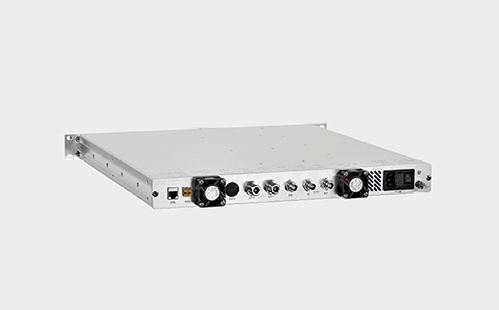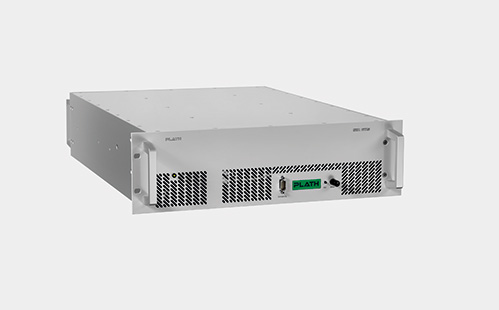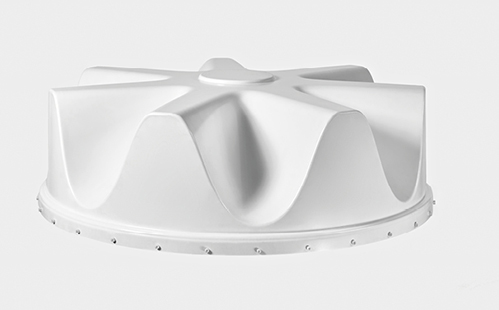| CATEGORY CAT | PRODUCT NAME NAME | MF | HF | VHF | UHF | SHF | MHZ |
|---|---|---|---|---|---|---|---|
| Direction-finding receiver | DFP 2175 | () | 20 - 3000 (6000) MHz | ||||
|
The new V/UHF direction-finding receiver DFP 2175 addresses the growing bandwidth demands of EW and COMINT missions and systems. The 80 MHz real-time bandwidth enables seamless direction-finding from 20 to 3000 MHz, with an optional extension to 6000 MHz. Its variable frequency resolution (1 and 8 kHz), high dynamic range and sensitivity meet all current demands. The consistent use of the 7-channel principle enables the calculation of 80 million bearings per second to provide seamless signal bearing, especially in high-density bands. The multipath-resistant direction-finding algorithm Vector Matching— a fully correlative interferometer algorithm using phase and amplitude—provides the DFP 2175 with the most robust and accurate direction-finding calculation in both stationary and scan modes.
Technical Highlights
(Subject to export control.)
Customer Advantages
|
|||||||
| Direction-finding receiver | DFP 2180 | () | 20 - 3000 (6000) MHz | ||||
|
The new V/UHF direction-finding receiver DFP 2180 addresses the growing bandwidth demands of EW and COMINT missions and systems. The DFP 2180 enables seamless direction finding from 20 to 3000 MHz, with an optional extension to 6000 MHz. The bandwidth, variable frequency resolution (1 and 8 kHz), high dynamic range and high sensitivity meet all current demands. The consistent use of the 7-channel principle enables the calculation of millions of bearings per second to provide seamless signal bearing, especially in high-density bands. The multipath-resistant direction-finding algorithm Vector Matching, a full correlative interferometer algorithm using phase and amplitude, provides the DFP 2180’s most robust and accurate direction-finding calculations in stationary and scan mode.
Technical Highlights
Customer Advantages
|
|||||||
| Direction-finding receiver | DFP 5050S | 0.5 - 30 MHz | |||||
|
The DFP 5050S is a direction-finding receiver, which covers a frequency range from 0.5 to 30 MHz. With a spectral resolution down to 7.81 Hz, it delivers very high bearing fidelity across a large dynamic range, which enables the clear separation of adjacent and overlapping signals. In addition to the conventional bearing results offered by a standard narrowband DF receiver, the DFP 5050S also offers the bearing and amplitude value of a Fast Fourier Transform (FFT) direction-finding receiver. In manual operation, signals of interest can be isolated easily.
Technical Highlights
Customer Advantages
|
|||||||
| Direction-finding receiver | DFP 5130 | 0.5 - 30 MHz | |||||
|
The DFP 5130 is direction-finding receiver, which covers a frequency range from 0.5 to 30 MHz. The receiver provides a coherent digital bandwidth of 12.288 MHz, which can be used in one block or in freely distributed subbands over the entire frequency range. With exceptional technical specifications, the DFP 5130 allows simultaneous interception of multiple bands at the same time and continuous calculation of bearing using the Watson-Watt method. DFP 5130 provides selectable narrowband DDC channels for simultaneous signal monitoring using the direction-finding antenna.
Technical Highlights
Customer Advantages
|
|||||||
| Direction-finding receiver | DFP 5135 | 0.5 - 30 MHz | |||||
|
The DFP 5135 is a direction-finding receiver, which covers a frequency range from 0.5 to 30 MHz. The receiver provides a coherent bandwidth of 29.5 MHz. With exceptional technical specifications, the DFP 5135 allows simultaneous interception of the entire band and the continuous calculation of bearings using the Watson-Watt method. The DFP 5135 is the perfect answer to the ever-growing need for fully automated HF COMINT systems and simply the best direction-finding receiver for this frequency range.
Technical Highlights
Customer Advantages
|
|||||||
| Monitoring receiver | SIR 2115 | () | 9 kHz - 3000 (6000) MHz | ||||
|
The SIR 2115 is a highly advanced wideband monitoring receiver. It supports a coherent bandwidth of 80 MHz and covers 9 kHz – 3 (6) GHz. With its extended RF coverage, RF spectrum support, extremely high-speed scan, digital wideband output, configurable narrowband receiver technology and market leading receiver fidelity and accuracy, the SIR 2115 is ideal for a range of different mission scenarios from manual to automatic interception in COMINT systems.
Technical Highlights
Customer Advantages
|
|||||||
| Monitoring receiver | SIR 5110 | 0.5 - 30 MHz | |||||
|
The SIR 5110 is a digital wideband monitoring receiver, which covers a frequency range from 0.5 to 30 MHZ using direct sampling. The receiver provides a coherent digital bandwidth of 12.288 MHz, which can be used in one block or in freely distributed sub-bands over the entire frequency range. With its excellent technical specifications, the SIR 5110 allows simultaneous interception of multiple bands at the same time – thereby replacing multiple normal receivers. The SIR 5110 competes effectively with dedicated narrowband receivers and has some of the best technical features of any digital wideband receiver.
Technical Highlights
Customer Advantages
|
|||||||
| Monitoring receiver | SIR 5115 | 0.5 - 30 MHz | |||||
|
The SIR 5115 is digital wideband monitoring receiver, which covers a frequency range from 0.5 to 30 MHz using direct sampling. The receiver provides a coherent bandwidth of 29.5 MHz. With exceptional technical specifications, the SIR 5115 allows simultaneous interception of entire bands at the same time – thereby replacing multiple normal receivers. The SIR 5115 is the answer to the ever-growing need for fully automated HF COMINT systems.
Technical Highlights
Customer Advantages
|
|||||||
| Direction-finding antenna | DFA 2440 | 20 - 3000 MHz | |||||
|
The direction-finding antenna DFA 2440 is a slim, lightweight antenna, which covers a frequency range from 20 to 3000 MHz. The antenna is designed for mobile and semi-mobile applications. The active seven channel antenna is vertically polarised and uses the correlative interferometer and vector matching DF methods. With high sensitivity even in the lower frequencies, the antenna is an excellent choice for all PLATH direction-finding receivers. The omni output is included as standard.
Technical Highlights
Customer Advantages
|
|||||||
| Direction-finding antenna | DFA 2441 | 20 - 6000 MHz | |||||
|
The direction-finding antenna DFA 2441 is a lightweight antenna, which covers a frequency range from 20 to 6000 MHz. The antenna is engineered for mobile and semi-mobile applications. The active seven channel antenna is vertically polarised and uses the correlative interferometer and vector matching DF methods. With high sensitivity even in the lower frequencies, the antenna is an excellent match for all PLATH direction-finding receivers in various applications. The omni output is included as standard.
Technical Highlights
Customer Advantages
|
|||||||
| Direction-finding antenna | DFA 2450 | () | 20 - 3000 (6000) MHz | ||||
|
The DFA 2450 is a high sensitivity, fully passive, seven channel direction-finding antenna, which covers a frequency range from 20 to 6000 MHz. Specially designed for maritime applications, the lightweight and compact antenna can be used in harsh environments and withstand wind speeds of up to 185 km/h when mounted on a suitable base. The dipole antenna is vertically polarised and uses effectively the correlative interferometer and vector matching DF methods.
Technical Highlights
Customer Advantages
|
|||||||
| Direction-finding antenna | DFA 2450A | () | 20 - 3000 (6000) MHz | ||||
|
The DFA 2450A is a high sensitivity, fully passive, seven channel direction-finding antenna, which covers a frequency range from 20 to 6000 MHz. Specially designed for mobile and semi-mobile applications, the lightweight and compact antenna can be used in harsh and maritime environments. It withstands wind speeds of up to 185 km/h (50 m/s) and has a high tolerance against radiation. The dipole antenna is vertically polarised and uses effectively the correlative interferometer and vector matching DF methods. The omni module is included as standard.
Technical Highlights
Customer Advantages
|
|||||||
| Direction-finding antenna | DFA 2451 | () | () | () | (0.5) 20 – 3000 (6000) MHz | ||
|
The DFA 2451 is a high sensitivity, fully passive, seven channel direction-finding antenna, which covers a frequency range from 0.5 to 6000 MHz. Also deployable in maritime applications, the lightweight antenna can be used in harsh environments and withstands wind speeds of up to 185 km / h when mounted on a suitable base. The dipole antenna is vertically polarised and uses effectively the correlative interferometer and vector matching DF methods.
Technical Highlights
Customer Advantages
|
|||||||
| Direction-finding antenna | DFA 2455 | () | () | () | (0.5) 20 – 3000 (6000) MHz | ||
|
The DFA 2455 is a high sensitivity, fully passive, stationary, seven channel direction-finding antenna, which covers a frequency range from 0.5 to 6000 MHz. The dipole antenna is vertically polarised and uses efficiently the correlative interferometer and vector matching DF methods. The 1.5-meter antenna extension provides an extremely high sensitivity between 20 MHz and 400 MHz. It is able to withstand harsh environments, even wind speeds of up to 185 km / h when mounted on a suitable base.
Technical Highlights
Customer Advantages
|
|||||||
| Direction-finding antenna | DFA 5080 | 0.5 - 30 MHz | |||||
|
The DFA 5080 is an active direction-finding antenna supporting the Watson-Watt direction-finding method. It features high bearing accuracy for ground and sky waves across 0.5 to 30 MHz. This system is well-suited for semi-mobile deployments. Its sensitivity and bearing accuracy are comparable with stationary passive systems. The scope of supply includes 100 m antenna cables and an internal antenna test equipment.
Technical Highlights
Customer Advantages
|
|||||||
| Direction-finding antenna | DFA 5083 | 0.5 - 30 MHz | |||||
|
The DFA 5083 is an active direction-finding antenna supporting the Watson-Watt direction-finding method. It features high bearing accuracy for ground and sky waves across 0.5 to 30 MHz. This antenna, consisting of two arrays, is well-suited for semi-mobile deployments. Its sensitivity and bearing accuracy are comparable with stationary passive systems. The scope of supply includes 100 m antenna cables and an internal antenna test equipment.
Technical Highlights
Customer Advantages
|
|||||||
| Direction-finding antenna | FAA 321 | 0.5 - 30 MHz | |||||
|
The FAA 321 is an active ferrite direction-finding antenna supporting the three channel Watson-Watt direction-finding method. It features high bearing accuracy across 0.5 to 30 MHz. Developed with a focus on weight, size, mobility and technical characteristics, this antenna can be installed easily on a tripod, a mast and on most platforms.
Technical Highlights
Customer Advantages
|
|||||||
| Direction-finding antenna | U 646 | 0.5 - 30 MHz | |||||
|
The U 646 is a highly sensitive direction-finding antenna for electromagnetic space and ground waves consisting of two bases. It utilises the Watson-Watt method and provides a high bearing accuracy for the frequency range from 0.5 MHz to 30 MHz. The concrete based antenna masts guarantee a space-saving installation without the need for suspension ropes. Even on poor conductive ground, the antenna operates reliably via in-built ground networks on every antenna mast. The passive antenna can be expanded with an in-built testing device ensuring flawless functioning.
Technical Highlights
Customer Advantages
|
|||||||
| Direction-finding antenna | U 656 | 0.5 - 30 MHz | |||||
|
The U 656 is a highly sensitive direction-finding antenna for electromagnetic space and ground waves consisting of two bases. It utilises the Watson-Watt method and provides a high bearing accuracy for the frequency range from 0.5 MHz to 30 MHz. The self-supporting antenna masts guarantee a space-saving installation without the need for suspension ropes. Even on poor conductive ground, the antenna operates reliably via in-built ground networks on every antenna mast. The passive antenna can be expanded with an in-built testing device ensuring flawless functioning.
Technical Highlights
Customer Advantages
|
|||||||
| Radio monitoring antenna | MAN 2115 | 9 kHz - 9000 MHz | |||||
|
Technical Highlights
Customer Advantages
|
|||||||
| Radio monitoring antenna | MAN 5180 | 0.5 - 30 MHz | |||||
|
The MAN 5180 is an active omnidirectional monitoring antenna developed for intercepting sky and ground waves across 0.5 to 30 MHz. With an installation time of just a few minutes the MAN 5180 is also suited for mobile operation. The adapted ground net ensures high performance on almost any surface. The package includes a transport box, power supply and cable.
Technical Highlights
Customer Advantages
|
|||||||
| Analysis software | DDA | all frequencies | |||||
|
The DDA (Direction-finding Data Analyzer) utilizes real-time big data analytics and a high-performance COTS hardware platform to deliver Interception Automation. It operates across the entire frequency spectrum. Besides the pre-classification of fixed frequency signals, DDA automates some of the most challenging COMINT tasks, such as capturing Low Probability of Intercept (LPI), burst, or frequency-hopping signals even in a very dense signal scenario. By pre-processing at the system edge, the DDA provides signal metadata and makes the information streamable in real-time even over low-bandwidth communication systems. The DDA is the key to automated remote operation of direction-finding services.
Technical Highlights
Customer Advantages
|
|||||||
| Analysis software | DDA 2 EXTENDED | 20 - 3000 (6000) MHz | |||||
|
The DDA (Direction-finding Data Analyzer) utilises real-time big data analytics and high-performance COTS hardware platform to deliver Interception Automation. Due to a completely new approach in segmentation, a significantly better separation of signals that are close together in terms of frequency or azimuth is achieved with the new DDA 2 version. It operates across the entire frequency spectrum. Besides the pre-classification of fixed frequency signals, DDA automates some of the most challenging COMINT tasks, such as capturing Low Probability of Intercept (LPI), burst or frequency hopping signals even in a very dense signal scenario. By pre-processing at the system edge, the DDA provides signal meta data and makes the information streamable in real-time even over low bandwidth connections. The new DDA algorithm is now more powerful and even more robust in relation to a wide variety of radio scenarios and signal volumes, and works up to a real-time bandwidth of 80 MHz. The DDA is the key to automated remote operating of direction-finding services.
Technical Highlights
Customer Advantages
|
|||||||
| Analysis software | SPACS | all frequencies | |||||
|
Signal Products Application for Control and Service Easy to configure and easy to use were the guidelines for the development of our new operating and configuration software SPACS. Signal Products Application for Control and Service SPACS is used to control, setup and configure SP devices and check for functionality. SPACS Monitoring includes many functions for manual operation of SP broadband monitoring receivers. SPACS Monitoring provides various views such as a spectrum data for search and analysis, amplitude spectrum, amplitude history and zoom spectrum and spectrogram (upward or downward). Internal short memory to pause and replay signal of interests. Recording of data (spectral data, IQ data depending on the view type) and loading of data and replay. Changing of FFT length and support of multiple cursers for measurement (e.g. frequency, bandwidth, time, amplitude) are some of the various features. SPACS supports different color schemes, various workspace settings and configurations options. SPACS Monitoring can manage up to 20 different views and is based on a future proven, latest openGL architecture to ensure future advances. SPACS has a superior performance, even on a normal notebook.
Technical Highlights
Customer Advantages
|
|||||||



































